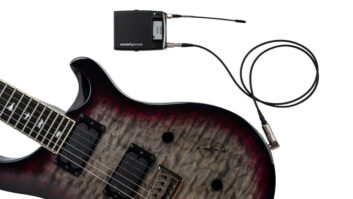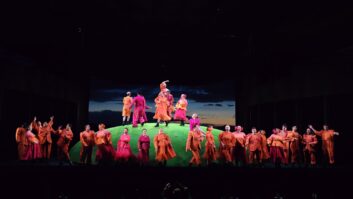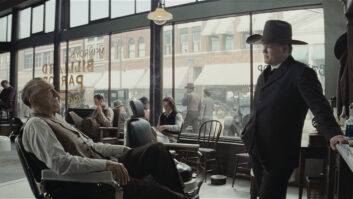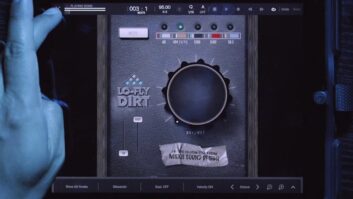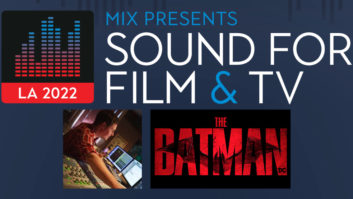Capturing Performance in Effects RecordingIt’s six weeks into a project and suddenly you realize the performance is not where it needs to be. The director has told you he needs something more dangerous, “chaotic, yet focused enough to do some damage.” In order to generate dramatic tension, it must be a threat to the actor playing opposite, and not just any actor. We’re talking about Arnold. Up-and-coming actor poised to break through in a big action film? Not quite. Seasoned professional, respected by insiders but unknown to the public at large? Much warmer. But if you’re still thinking actors, you’re on the wrong track. Performance – whether of vehicles, machinery or wind – is also the domain of the sound effects recordist who serves the interest of sound design and plot. The bottom line for any recordist may be coverage, but when a director sits down with the sound team to discuss the track, it is the crucial moments of the film he or she is concerned with; a scene may call for a particular palette of sounds – curtains, floor creaks – to give life to a room, or the objects, possessions, or car of a main character, maybe even the machine in the end that will kill him.
It takes imagination, musicality, ingenuity and technical know-how to find the right gadget, the right machine or the right location and then capture it in a compelling manner. There are numerous variables to consider – recording rigs, channels, settings, mic angles, locations, wind and relative humidity for starters. Then, there is the fact that certain sounds can be generated by anything from spaghetti to eggshells to a side of beef, say bones breaking as an element for a car crash. Finally, depending upon where it occurs and the type of film, there is the story to consider – as we will see, an effect can be said to have a persona.
It stands to reason, then, that there is no such thing as the right sound. Ask three recordists to record a particular effect, and you’ll no doubt get three different results, all of which provide a portal into their particular aural universe. The range of thinking, methodology and response to a physical environment is epitomized in the examples of Eric Potter, Ben Cheah and Ren Klyce, who have worked in this capacity to create some of the most striking and evocative sounds in film today.
Potter, of Weddington Productions in North Hollywood, is a tinkerer. He reveres old machines and with a finely tuned ear can turn them for his purposes. The electric chair in The Green Mile, the cars in action films like Twister and Ronin, and the froggy rain in Magnolia are just a few examples of his work.
Cheah, a recordist and sound designer out of C5 in New York, uses perspective to give breadth and personality to his recording; the wood-chipper in Fargo and a chain saw in American Psycho must surely take their place in the cinematic pantheon of motorized limb cutters.
Klyce was the sound designer on the films Seven, The Game and Fight Club, for which he received an Academy Award nomination. David Fincher, who directed the three films, has forged with Klyce an unusual relationship, allowing him unique access to sets and locations. The results are tracks with intensity and depth that play a pivotal role in establishing character, emotion and “a sense that you can touch the place where these people are.”
SOMETHING NEWSo often in this digital age, sound designers see their work in terms of how sound is manipulated after it is recorded rather than in the recording itself. Far from being unique to a given film, many of the effects we hear come from libraries that have existed for years, if not decades. It may make sense to grab an effect off a network or a CD and then fit it with reverb later on. However, some of the standard library recordings have become so familiar to editors as to border on the cliche. A personal film, with its own peculiarities, may require something more.
“We try never to go to the sound effects library,” says Cheah, who works with directors Woody Allen, Spike Lee and Martin Scorsese. “Every sound company in the world has those same five or ten libraries, so rather than going for the stock-standard mono-sound recording of a door close at 3 inches – very clinical, clean sound – we try to record things with lots of room.”
Like camera angles and lighting on the picture side, mic distance and room ambience are tools that underscore authenticity and feeling, which is why the access Klyce has to sets is so valuable. “It’s a great thing to be able to go into the rooms, particularly when the rooms have a lot of what I call sauce – reverberance, door slams in the background, a drawer being opened and closed – but recorded from the distance is the camera.”
For Klyce, the relationship to recording is akin to that of an artist who mixes his own colors. “One of the most exciting parts to me of starting a project is to create a whole new palette. It’s very tedious, but it’s also a lot of fun.”
Often, time and budget constraints preclude the creation of an entire library for an individual film. So after spotting a film with the director, the editors will get an idea of what’s usable from libraries, including their own catalogs of previously recorded material, then create a wish list of unique or difficult-to-find material. Sometimes, it’s simply a matter of tracking down the item in question. “In Beloved,” says Cheah, “there’s a hand-driven water pump. There’s only like one in all of New York state, but Jonathan Demme wanted that sound.”
TOOLS AND TECHNIQUESAs far as what equipment to carry, geography can also be a factor. Potter likes the 24-bit Nagra D, which Cheah calls, “a beautiful machine, but just not realistic.” For Potter, working in the open spaces of California, a machine with the 4-track capability of the digital Nagra makes sense. But on foot in the Big Apple, as Cheah often is, you’d better be discrete and fast on the ground.
“For bars and public spaces, where carrying around anything that looks remotely like a handgun will often get you shot,” Cheah employs what he calls “the stealth mic kit from Sonic Studios – two very high-quality capsules that hang off sunglasses or fit inside a pocketbook. The manufacturer is really hip; he mods the Sony PCM-M1 DAT machine and puts a high-quality mic preamp in it.”
In terms of modulation and range, a mic will make all the difference in how an effect plays. For vehicle recordings, Potter finds that the Neumann KM100 condenser mics provide excellent detail in the middle range. “Sometimes, I’ll try cardioid X-Y stereo and at times I will also use a KMR81 or 82 shotgun. We were using Sennheiser 416s and 816s, then the Neumann 81s and 82s became known. I used one in a Foley session and I liked the character of that mic. I brought it out in the field for a vehicle and it turned out to be our favorite shotgun.”
Klyce uses a range of mics, but has been inclined of late to record to a single channel. “It’s sort of up to the scene, how wide you want the image to be,” he explains. “I do like stereophonic recording, but sometimes it’s fun to capture ambiences with a mono microphone. You sort of cut all these little bits and pieces together, spread them out within the stereo spectrum and create a pseudo-stereo sound.”
Sometimes, the sound an object makes is less than sufficient. “Often, it’s just not dramatic enough,” says Potter. “That’s where the noggin comes in.” His example from Total Recall, which I alluded to in the introduction, shows how far at times you have to go to make something work.
“There was a subterranean drilling machine chasing Arnold in these tunnels underneath the planet,” he says. “We needed an additional whirring or cycling element to illustrate the giant drill bit in the front of the vehicle, so the idea of a flange sound came up. I noticed an old lawn mower at a prop house called `History For Hire.’ I saw those blades and I realized that this needed to be recorded.
“But it wasn’t quite enough,” he continues. “I needed more sense of racket. I taped my crescent wrench over the blades, which made it clank like a broken jackhammer, but with a weird scraping and slicing. That was the thing that made it hyper-real.”
Like an actor adding layers to a performance, it’s that unexpected element that can fulfill a missing “feel.” What Potter has dubbed “psycho-acoustics” is applicable to people as well. Witness Klyce’s work with the character of Marla in Fight Club.
“She comes in and she smokes and it’s this fire,” he says. “She’s the devil, basically, but I didn’t want to do it in a way that was obvious with, you know, cackling laughter. It ended up being very subtle sounds, which were actually very softly recorded flames for her inhales and exhales, then heavily processed. She lights her cigarette and it’s like, `Tssss-hchchhhhh.'”
Cheah, whose background as a Foley supervisor informs his effects work, wanted to add an undertone of High Noon to a boardroom meeting in American Psycho. “Patrick Bateman, the serial killer, is extremely jealous of one of the guys in the company. There’s all this pinpoint, stylized Foley of card cases opening, card handling, big close-ups of business cards being slid across tables. To do the card cases, I recorded a lot of gun elements, like maybe we weren’t really dealing with a yuppie scene but a poker game in a western.”
The practice of inserting disparate sounds at dramatic moments shows how synthetic the creation of effects still is. As Cheah puts it, “We’re making movies and not documentaries. We don’t naturally follow authenticity. We follow the dramatic intention.”
REALITY, AND THEN SOMEThis is not to say reality doesn’t have a place. Sound designer Walter Murch used to suggest that students walk around with their eyes closed to get an idea of what sounds were actually out there. But only the production mixer, who is concerned primarily with clean dialog, is there at the moment of filming. Reality, then, is at best a construction. “Oftentimes, when people walk outside their houses in movies, all of a sudden you hear birds chirping and dogs barking,” notes Klyce. “It might seem ridiculous to put those things in, but those things do happen. I remember just recently walking out of my house and I opened the door and there was the dog, there was the bird, there was the car. It was just absolutely hysterical. I was listening, going, `this is just ridiculous, it sounds like a movie.'”
Klyce’s work with David Fincher has become recognized for its complexity and a certain degree of stylization. The intensity of their collaboration means they may begin in reality, go through a level of manipulation, and then wind up someplace entirely different. Klyce refers to a “fun, stylized moment at the beginning of Fight Club where Jack [Edward Norton] is talking about his insomnia problem, and you can hear the clock next to his bed just annoyingly loud. We cut to his work and he’s in his office in front of the Xerox machine. David wanted it to sound like Metropolis, so I sampled all these motor sounds and mechanical sounds and cut in this sort of musical piece that coincided with the music cue. I spent days on it, putting all my little servos in the key of the music – we’re talking about a lot of work. It was one of those things that was so ornate and it was very funny, but at the very last minute I just thought, this is too much. It ended up just being absolutely nothing except this one note on the synthesizer.”
Given the ever-changing demands of recording, it’s not surprising that Klyce found himself drawing upon skills acquired in a previous incarnation as a musician. Potter, who gives further credence to the performance aspect of recording, talks about engines the way a concertmaster talks about violins. “On the classic American V-8,” he says, in explanation of his technique for car interiors, “you can get that meatier, vroomy sound by working near the intake of the air cleaner. Mic on the exhaust, tailpipe, a mic up by the engine. I’ll hold my breath while I have somebody rev, do a little tweaking, find a sweet spot there, then put a stereo pair inside the car.
“I get all that stuff together and I figure at that point I might as well just get in and drive it myself,” he laughs. “I’ve got the scene or the type of action that’s needed inside my head and I’ve spent much of the day trying to convey that to a driver, who’s been doing these exterior perspective maneuvers. But now I get the instantaneous feedback from my brain to my foot to the throttle to the microphone back in my ears.”
The car, then, is essentially performed with motivations and personal attributes as befit a character. Potter provides an instance from a film called Larger Than Life where the vehicle functioned as a doppleganger. “We wanted this old guy’s truck to intimidate the Bill Murray character. We auditioned trucks around Los Angeles and found something that wasn’t too precious sitting in a back lot. The truck still had to match what you see on the screen. From there, we aimed for the character aspect; in this case sort of funkifying the vehicle, taking the exhaust apart maybe drilling a couple of holes. At one point, we went as far as altering the spark plugs so that it was firing in the wrong order, to cough and sputter upon acceleration.”
FEEDING FOLEYThe performance of certain effects is also the domain of Foley, or “a very clear attempt to grab that gray area between Foley and sound effects and run with it,” as Cheah puts it, “rather than, `Well, do you want to do that?’ `No, you can do that,’ or `I’ll do that,’ these kind of conversations that always go on between sound effects and Foley editors.”
Cheah and Klyce have both come up with imaginative ways to cover similar ground outside the Foley stage. Potter, who worked on The Green Mile, leaves that for his Weddington colleagues (see “Walking The Green Mile,” Mix, January 2000).
“I’ll go and find an interesting staircase from an old house,” says Cheah, referring to a sort of loose effort to transport the sync capability of the Foley stage to a live location. “I have an assistant break the scenes down and record them to an 8mm clamshell video player. The Foley guys actually get very used to it and they can walk down the stairs with the video player in their hand.”
On Fight Club, Klyce used “guerrilla Foley,” or in this case gorilla Foley, to great advantage for the character Marla, an area of particular concern for him and director David Fincher. “Helena [Bonham-Carter] comes walking down the stairs in her big clunker shoes and says, `The condom is the glass slipper of our generation.’ The idea David and I had was to make this very small, dainty woman sound like she’s an elephant. We went through something like 14 pairs of shoes before we found the perfect pair. The Foley crew, Malcolm Fife, John Roesch, Hilda Hodges and I went to the set one evening, which was amazing because it was an actual house. John would count out, `Fifty-seven, fifty-eight.’ He’d snap his fingers and then Hilda would walk down the stairs sort of memorizing the steps because she couldn’t watch the television.”
Another way to add dimension to recordings is to vary perspective. Editors bemoan the uniform miking of sound effects libraries, but a prop like the chain saw in American Psycho can require some pretty inventive techniques on the part of the recordist. “There’s a lot of offscreen action and we’re supposed to know what’s going on,” explains Cheah. “The challenge is to create that offscreen drama and the perspective of the chain saw approaching and moving away from our dramatic point-of-action.”
In order to anticipate the complexity of a scene, Potter likes “to provide all the possibilities.” His work on Magnolia demonstrates how, through an array of perspectives, a car can tell a story of its own:
“Later on in the film, where the ambulance is trying to get to the hospital with a patient, they’re dealing with the fact that it’s raining frogs,” he relates. “To create a sense of a storm front coming in across the San Fernando Valley, we pounded a lot of different fleshy objects on car roofs and pavement. Then we did a `worldizing’ session in a canyon with speakers on the back of a pickup truck and drove into the mic at various speeds with the engine turned off.
“They’re driving erratically, and then the ambulance just lurches off to the right and goes out of frame,” he continues. “We needed a lot of struggling and straining of the engine, and we needed a tracking perspective. I rented a minivan with a sliding door on the right side and [used] a shotgun mic and a walkie-talkie to give instructions to the driver, keying the microphone a little bit when to accelerate and when to swerve away, varying speed to find a sweet spot in either first or second gear.
“When something comes off mic and goes away, you get that sense of radical change and something possibly going wrong. The dramatic action is most immediately conveyed by the sound of the engine and the perspective changing radically.”
Sometimes, as Klyce discovered when he set himself the task of creating sadness, what you do off camera can be just as compelling as what you do on it.
“In Fight Club, there’s this woman and she’s basically saying that she’s going to die,” he says. “Everyone who’s in the room watching her is very silent. I thought, well, what sadder sound than to put the sound of happiness.
“I hired a bunch of children and we went into a church and we were actually collecting sounds for a different scene. We called a break and said, `Why don’t you guys just go run around.’ But we kept rolling, so the kids ran out and they’re laughing and they’re chasing each other and they’re giggling and it was from another room. It’s funny because David wanted to get rid of those kids and we actually argued about it. I guess I won.”
FILLING IN THE BGsBackgrounds and ambiences play a profound role in setting a tone. But unlike with a car or machine or inanimate object, the recordist is even more limited by geography. Cheah makes a virtue of being in New York through an acute awareness of his surroundings and a willingness to incorporate what’s out there. “There are just so many people and there is so much activity going on that there are always interesting, weird and inexplicable sounds going on in the background. If you’re on the right side of town, you pretty much hang a microphone out the window.”
Any filmmaker who features an urban setting stands to gain from this. But when your setting is ancient Rome, as in the case of Titus, the advantage of a city takes on new meaning. “Columbia University has this enormous rotunda, a marble vault library, and we got it locked off for ourselves to record sounds like arrows flying and things breaking after the orgy scene in the emperor’s palace,” Cheah recalls. “The Senate scenes, shots on the steps, anything that would have a live sound. It must have been like a nine-second delay time, bouncing around these walls; it was insane.”
With all the work that needs to be done for a quality recording, it may be easy to forget that the most important tools we have are two monitors custom-built into the sides of our heads. An ability to let things just happen and to know when to get out of the way can make all the difference.
Potter recalls, “Recording on the bridge of a nuclear submarine with the commander, at one point I said, `I’d like to have the sound of the collision alarm for 30 seconds.’ And he turns to the lieutenant and says, `Sound the collision alarm for 30 seconds.’ He does it and I realize that I am in effect giving orders on board the U.S. Navy’s multimillion-dollar nuclear submarine.
“Moments like that,” he notes, “I’m just standing there being quiet, being observant, listening for any background sounds that I want to try to avoid. The interesting thing is this sense of heightened awareness that makes the reality of a situation potentially very meaningful. It’s the kind of thing we might try to achieve through meditation. Well, if you want to `be here now,’ try doing a good job recording ambiances.”
